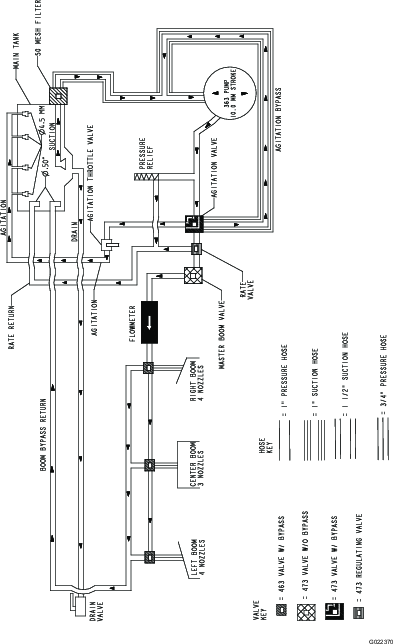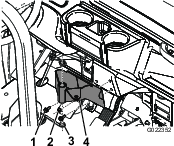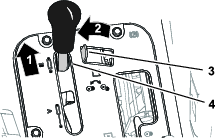| Maintenance Service Interval | Maintenance Procedure |
|---|---|
| Yearly |
|
Introduction
Read this manual carefully to learn how to operate and maintain your product properly. The information in this manual can help you and others avoid injury and product damage. Although Toro designs and produces safe products, you are responsible for operating the product properly and safely. You may contact Toro directly at www.Toro.com for product and accessory information, help finding a dealer, or to register your product.
Whenever you need service, genuine Toro parts, or additional information, contact an Authorized Service Dealer or Toro Customer Service and have the model and serial numbers of your product ready. Figure 1 illustrates the location of the model and serial numbers on the product.
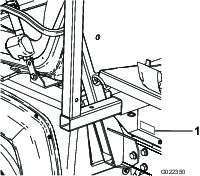
This manual identifies potential hazards and has safety messages identified by the safety alert symbol (Figure 2), which signals a hazard that may cause serious injury or death if you do not follow the recommended precautions.

This manual uses 2 words to highlight information. Important calls attention to special mechanical information and Note emphasizes general information worthy of special attention.
The Multi Pro WM is a dedicated turf spray modification for Workman vehicles and is intended to be used by professional, hired operators in commercial applications. It is primarily designed for spraying on well-maintained lawns in parks, golf courses, sports fields, and on commercial grounds.
This product complies with all relevant European directives; for details, please see the separate product specific Declaration of Conformity (DOC) sheet.
Warning
CALIFORNIA
Proposition 65 Warning
Use of this product may cause exposure to chemicals known to the State of California to cause cancer, birth defects, or other reproductive harm.
Safety
Improper use or maintenance by the operator or owner can result in injury. To reduce the potential for injury, comply with these safety instructions and always pay attention to the safety alert symbol. Failure to comply with the instruction may result in personal injury or death.
Safe Operating Practices
Warning
The Workman equipped with a spray system is an off-highway vehicle only and is not designed, equipped, or manufactured for use on public streets, roads, or highways.
Do not drive the workman on public streets, roads, or highways.
The Workman was designed and tested to offer safe service when operated and maintained properly. Although hazard control and accident prevention partially are dependent upon the design and configuration of the machine, these factors are also dependent upon the awareness, concern, and proper training of the personnel involved in the operation, maintenance and storage of the machine. Improper use or maintenance of the machine can result in injury or death.
This is a specialized utility vehicle designed for off–road use only. Its ride and handling will have a different feel than what drivers experience with passenger cars or trucks. So take time to become familiar with your Workman.
Not all of the attachments that adapt to the Workman are covered in this manual. See the Operator’s Manual provided with attachment for additional safety instructions.
Supervisor's Responsibilities
-
Make sure that operators are thoroughly trained and familiar with the Operator’s Manual, Training Material, Engine Manual, and all labels on the Workman vehicle.
-
Be sure to establish your own special procedures and work rules for unusual operating conditions (e.g. slopes too steep for vehicle operation). Use the third high lockout switch if high speed could result in a safety or vehicle abuse situation.
Chemical Safety
Warning
Chemical substances used in the spray system may be hazardous and toxic to you, bystanders, animals, plants, soils or other property.
-
Carefully read and follow the chemical warning labels and Material Safety Data Sheets (MSDS) for all chemicals used and protect yourself according to the chemical manufacturer's recommendations. For example, use appropriate Personal Protective Equipment (PPE) including face and eye protection, gloves, or other equipment to guard against personal contact with the chemical.
-
Keep in mind that there may be more than one chemical used, and information on each chemical should be assessed.
-
Refuse to operate or work on the sprayer if this information is not available!
-
Before working on a spray system, make sure that the system has been triple rinsed and neutralized according to the recommendations of the chemical manufacturer(s) and all of the valves have been cycled 3 times.
-
Verify there is an adequate supply of clean water and soap nearby, and immediately wash off any chemicals that contact you.
-
Obtain proper training before using or handling chemicals.
-
Use the correct chemical for the job.
-
Follow the chemical manufacturer's instructions for the safe application of the chemical.
-
Handle chemicals in a well ventilated area.
-
Wear goggles and other protective equipment as instructed by the chemical manufacturer. Ensure that as little skin as possible is exposed while using chemicals.
-
Have clean water available especially when filling the spray tank.
-
Do not eat, drink, or smoke while working with chemicals.
-
Always wash your hands and other exposed areas as soon as possible after finishing the work.
-
Properly dispose of unused chemicals and chemical containers as instructed by the chemical manufacturer and your local codes.
-
Chemicals and fumes in the tanks are dangerous; never enter the tank or place your head over or in the opening.
-
Follow all local/state/federal requirements for the spraying of chemicals.
Before Operating
-
Operate the machine only after reading and understanding the contents of this manual.
-
Never allow children to operate the sprayer.
-
Never operate the sprayer without first reading and understanding the Operator's Manual. Only trained and authorized persons should operate this sprayer. Make sure that all operators are physically and mentally capable of operating the sprayer.
-
This vehicle is designed to carry the operator and one passenger in the seat provided by the manufacturer. Never carry any other passengers on the vehicle.
-
Never operate the sprayer when under the influence of drugs or alcohol. Even prescription drugs and cold medicines can cause drowsiness.
-
Do not drive the sprayer when you are tired. Be sure to take occasional breaks. It is very important that you stay alert at all times.
-
Become familiar with the controls and know how to stop the engine quickly.
-
Keep all shields, safety devices, and decals in place. If a shield, safety device, or decal is malfunctioning, illegible, or damaged, repair or replace it before operating the machine.
-
Always wear substantial shoes. Do not operate the machine while wearing sandals, tennis shoes, or sneakers. Do not wear loose fitting clothing or jewelry which could get caught in moving parts and cause personal injury.
-
Wearing safety glasses, safety shoes, long pants, and a helmet is advisable and required by some local safety and insurance regulations.
-
Keep everyone, especially children and pets, away from the areas of operation.
-
Be extremely careful when operating around people. Always be aware of where bystanders might be and keep them away from the work area.
-
Before operating the vehicle, always check all parts of the vehicle and any attachments. If something is wrong, stop using the vehicle. Make sure that the problem is corrected before vehicle or attachment is operated again.
-
Since gasoline is highly flammable, handle it carefully.
-
Use an approved gasoline container.
-
Do not remove the cap from the fuel tank when the engine is hot or running.
-
Do not smoke while handling gasoline.
-
Fill the fuel tank outdoors, and fill it to about 25 mm (1 inch) below the top of the tank (the bottom of the filler neck). Do not overfill it.
-
Wipe up any spilled gasoline.
-
-
Use only an approved non-metal, portable fuel container. Static electric discharge can ignite gasoline vapors in a ungrounded fuel container. Remove the fuel container from the bed of the vehicle and place on the ground away from the vehicle before filling. Keep nozzle in contact with container while filling.
-
Check the safety interlock system daily for proper operation. If a switch should malfunction, replace the switch before operating machine.
While Operating
Warning
Engine exhaust contains carbon monoxide, which is an odorless, deadly poison that can kill you.
Do not run engine indoors or in an enclosed area.
-
Operator and passenger should remain seated whenever the vehicle is in motion. Operator should keep both hands on steering wheel, whenever possible and passenger should use hand holds provided. Keep arms and legs within the vehicle body at all times. Never carry passengers in the box or on attachments. Remember your passenger may not be expecting you to brake or turn and may not be ready.
-
Always watch out for and avoid low overhangs such as tree limbs, door jambs, and over-head walkways. Make sure there is enough room over head to easily clear the vehicle, sprayer booms and your head.
-
When starting the engine:
-
Sit on operator’s seat and ensure parking brake is engaged.
-
Disengage PTO and return hand throttle lever to Off position.
-
Move shift lever to Neutral and depress clutch pedal.
-
Keep foot off accelerator pedal.
-
Turn ignition key to Start.
-
-
Using the machine demands attention. Failure to operate vehicle safely may result in an accident, tip over of vehicle and serious injury or death. Drive carefully. To prevent tipping or loss of control:
-
Use extreme caution, reduce speed and maintain a safe distance around sand traps, ditches, creeks, ramps, and any unfamiliar areas or other hazards.
-
Watch for holes or other hidden hazards.
-
Use caution when operating vehicle on a steep slope. Normally travel straight up and down slopes. Reduce speed when making sharp turns or when turning on hillsides. Avoid turning on hillsides whenever possible.
-
Use extra caution when operating vehicle on wet surfaces, at higher speeds or with a full load. Stopping time will increase with a full load. Shift into a lower gear before starting up or down a hill.
-
Avoid sudden stops and starts. Do not go from reverse to forward or forward to reverse without first coming to a complete stop.
-
Do not attempt sharp turns or abrupt maneuvers or other unsafe driving actions that may cause a loss of vehicle control.
-
Do not pass another vehicle traveling in the same direction at intersections, blind spots, or at other dangerous locations.
-
When draining, do not let anyone stand behind vehicle and do not drain liquid on any one’s feet.
-
Keep all bystanders away. Before backing up, look to the rear and assure no one is behind. Back up slowly.
-
Watch out for traffic when near or crossing roads. Always yield the right of way to pedestrians and other vehicles. This vehicle is not designed for use on streets or highways. Always signal your turns or stop early enough so other persons know what you plan to do. Obey all traffic rules and regulations.
-
Never operate vehicle in or near an area where there is dust or fumes in the air which are explosive. The electrical and exhaust systems of the vehicle can produce sparks capable of igniting explosive materials.
-
If ever unsure about safe operation, stop work and ask your supervisor.
-
-
Do not use a cab on a Workman vehicle equipped with a spray system. The cab is not pressurized and will not provide adequate ventilation when used with a sprayer. The cab will also overload the vehicle when the spray system tank is full.
-
Do not touch engine, transaxle, muffler or muffler manifold while engine is running or soon after it has stopped because these areas may be hot enough to cause burns.
-
If the machine ever vibrates abnormally, stop immediately, turn engine off, wait for all motion to stop and inspect for damage. Repair all damage before resuming operation.
-
Before getting off the seat:
-
Stop movement of the machine.
-
Shut engine off and wait for all movement to stop.
-
Set parking brake.
-
Remove key from ignition.
Note: Block wheels if machine is on an incline.
-
-
Lightning can cause severe injury or death. If lightning is seen or thunder is heard in the area, do not operate the machine; seek shelter.
Braking
-
Slow down before you approach an obstacle. This gives you extra time to stop or turn away. Hitting an obstacle can damage the vehicle and its contents. More important, it can injure you and your passenger.
-
Gross Vehicle Weight (GVW) has a major impact on your ability to stop and/or turn. Heavy loads and attachments make a vehicle harder to stop or turn. The heavier the load, the longer it takes to stop.
-
Turf and pavement are slick when they are wet. It can take 2 to 4 times as long to stop on wet surfaces as on dry surfaces. If you drive through standing water deep enough to get the brakes wet, they will not work well until they are dry. After driving through water, you should test the brakes to make sure they work properly. If they do not, drive slowly while putting light pressure on the brake pedal. This will dry the brakes out.
Operating on Hills and Rough Terrain
Operating the vehicle on a hill may cause tipping or rolling of the vehicle, or the engine may stall and you could lose headway on the hill. This could result in personal injury.
-
Do not accelerate quickly or slam on the brakes when backing down a hill, especially with a load.
-
Never drive across a steep hill; always drive straight up or down or go around the hill.
-
If the engine stalls or you begin to lose headway while climbing a hill, gradually apply the brakes and slowly back straight down the hill.
-
Turning while traveling up or down hills can be dangerous. If you have to turn while on a hill, do it slowly and cautiously. Never make sharp or fast turns.
-
Heavy loads affect stability. Reduce the weight of the load and your speed when operating on hills.
-
Avoid stopping on hills, especially with a load. Stopping while going down a hill will take longer than stopping on level ground. If the sprayer must be stopped, avoid sudden speed changes, which may initiate tipping or rolling of the sprayer. Do not slam on the brakes when rolling backward, as this may cause the sprayer to overturn.
-
Reduce speed and load when operating on rough terrain, uneven ground, and near curbs, holes, and other sudden changes in terrain. Loads may shift, causing the sprayer to become unstable.
Loading
The weight of the cargo can change the Workman center of gravity and handling. To avoid loss of control and personal injury, follow these guidelines:
-
Reduce the weight of the load when operating on hills and rough terrain to avoid tipping or overturning of the vehicle.
-
Liquid loads can shift. This shifting happens most often while turning, going up or down hills, suddenly changing speeds, or while driving over rough surfaces. Shifting loads can cause the vehicle to tip over.
-
When operating with a heavy load, reduce your speed and allow for sufficient braking distance. Do not suddenly apply the brakes. Use extra caution on slopes.
-
Be aware that heavy loads increase your stopping distance and reduce your ability to turn quickly without tipping over.
Maintenance
-
Only permit qualified and authorized personnel to maintain, repair, adjust, or inspect the vehicle.
-
Before servicing or making adjustments to the machine, stop the engine, set the parking brake, and remove the key from the ignition to prevent someone from accidentally starting the engine.
-
Empty the tank before tilting or removing sprayer from vehicle and before storage.
-
Never work under a sprayer without using tank support prop rod.
-
Make sure all hydraulic line connectors are tight, and all hydraulic hoses and lines are in good condition before applying pressure to the system.
-
Keep body and hands away from pin hole leaks that can eject hydraulic fluid under high pressure. Use paper or cardboard, not hands, to search for leaks.
Danger
Hydraulic fluid escaping under pressure can have sufficient force to penetrate skin and do serious damage.
If fluid is injected into the skin it must be surgically removed within a few hours by a doctor familiar with this form of injury or gangrene may result.
-
Before disconnecting or performing any work on the hydraulic system, all pressure in system must be relieved by stopping engine, cycling dump valve from raise to lower and/or lowering the tank and attachments. If the tank must be in the raised position, secure it with the safety support.
-
To make sure entire machine is in good condition, keep all nuts, bolts and screws properly tightened.
-
To reduce potential fire hazard, keep the engine area free of excessive grease, grass, leaves and accumulation of dirt.
-
If the engine must be running to perform a maintenance adjustment, keep hands, feet, clothing, and any parts of the body away from the engine and any moving parts. Keep everyone away.
-
Do not overspeed engine by changing governor settings. Maximum engine speed is 3650 rpm. To assure safety and accuracy, have an Authorized Toro Distributor check maximum engine speed with a tachometer.
-
If major repairs are ever needed or assistance is required, contact an Authorized Toro Distributor.
-
To be sure of optimum performance and safety, always purchase genuine Toro replacement parts and accessories. Replacement parts and accessories made by other manufacturers could be dangerous. Altering this vehicle in any manner may affect the vehicle’s operation, performance, durability or its use may result in injury or death. Such use could void the product warranty of The Toro® Company.
-
This vehicle should not be modified without The Toro® Company’s authorization. Direct any inquiries to The Toro® Company, Commercial Division, Vehicle Engineering Dept., 300 West 82nd St., Bloomington, Minnesota 55420–1196. USA
-
Refer to your vehicle’s Operator’s Manual for other maintenance.
Safety and Instructional Decals
 |
Safety decals and instructions are easily visible to the operator and are located near any area of potential danger. Replace any decal that is damaged or lost. |
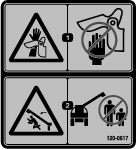


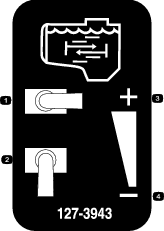
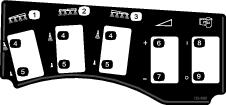
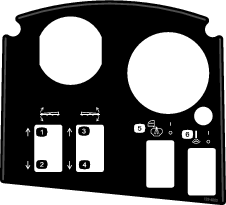
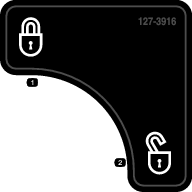
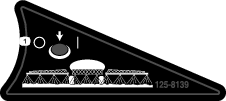
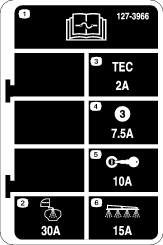
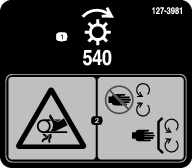
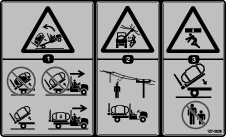
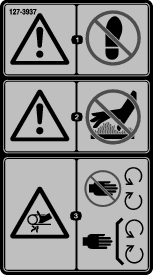
Setup
Note: Determine the left and right sides of the machine from the normal operating position.
Removing the Existing Bed
-
Start the engine.
-
Engage the hydraulic lift lever and lower the bed until the cylinders are loose in the slots.
-
Release the lift lever and turn off the engine.
-
Remove the lynch pins from the outer ends of the cylinder rod clevis pins (Figure 3).
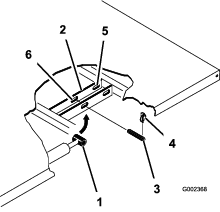
-
Remove the clevis pins securing the cylinder rod ends to the bed mounting plates by pushing the pins toward the inside (Figure 3).
-
Remove the lynch pins and clevis pins securing the pivot brackets to the frame channels (Figure 4).
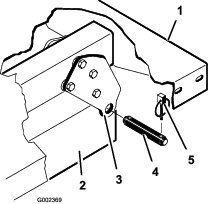
Caution
The full bed weighs approximately 95 kg (210 lbs), so do not try to install or remove it by yourself. Get the help of 2 or 3 other people or use an overhead crane.
-
Lift the bed off the vehicle.
-
Store the cylinders in storage clips. Engage the hydraulic lift lock lever on the vehicle to prevent accidental extension of the lift cylinders.
Installing the Power Take-Off (PTO) Kit
Suspend the setup of the Multi Pro WM at this time to install the PTO kit. Refer to the accompanying Installation Instructions for more information.
Continue to the next step once you have installed the kit.
Installing the Control Console
Parts needed for this procedure:
| Control console | 1 |
| Hair pin | 1 |
Mount the control console onto the storage bracket located on the front right tank strap with a hair pin (Figure 5).
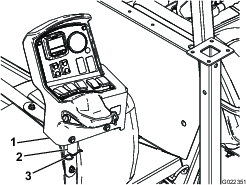
Installing the Console Mounting Bracket
Parts needed for this procedure:
| Console mounting bracket | 1 |
| Flange nut (5/16 inch) | 3 |
| Flange head bolt (5/16 inch) | 3 |
| Plastic bushing | 2 |
On some vehicles, the control mount plate is attached to the dashboard at the same point the hand throttle assembly is mounted. If the hand throttle kit is installed separate it from the dashboard to install the control mount plate. Refer to the Hand Throttle Kit Operator’s Manual for directions in removing and installing the hand throttle assembly.
Installing the Attachment Hold-down Brackets
Parts needed for this procedure:
| Hold-down brackets | 2 |
-
Locate and remove the 2 rear bolts and flange nuts on the lift cylinder bracket (Figure 7).
Note: Retain the fasteners for later use.
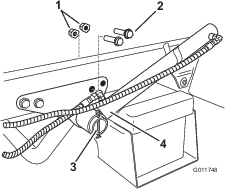
-
Remove the cotter pin securing the lift cylinder to the bracket, and slide the lift cylinder outward to allow for the installation of the hold-down brackets.
-
Install the hold-down brackets using the 2 bolts and flange nuts removed previously (Figure 8).
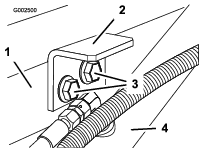
-
Install the previously removed cotter pin.
-
Repeat the procedure on the opposite side.
Installing the Tank Skid
Parts needed for this procedure:
| Tank and skid assembly | 1 |
| Clevis pins | 2 |
| Tapered clevis pin | 2 |
| Hair pins | 2 |
| Lynch pins | 4 |
| Bolt (1/2 x 1-1/2 inches) | 2 |
| Nuts (1/2 inch) | 2 |
Danger
The sprayer tank assembly represents a stored energy hazard. If not properly retained when installing or removing the assembly, it can move or fall and injure you or other bystanders.
Use straps and an overhead lift to support the sprayer tank assembly during installation, removal, or any maintenance when the retaining fasteners are being removed.
-
Using a lift, raise the tank skid assembly (Figure 9) and position it over the vehicle frame with the pump and valve assemblies facing rearward.
Note: Have another person help you perform the following steps.
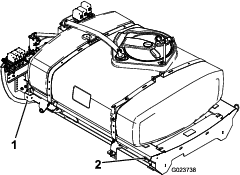
-
Slowly lower the tank skid to the frame.
-
Connect the negative battery cable and start the vehicle to energize the hydraulic pumps.
-
Extend the lift cylinders to the brackets on the tank skid, and align the cylinder arms with the holes in the tank skid brackets (Figure 10).
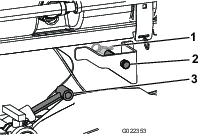
-
Use the clevis pin and hair pin to secure the tank skid to the lift cylinders on both sides of the vehicle.
-
Line up the pivot lug at the rear of the tank skid assembly with the opening at the end of the vehicle frame (Figure 11).
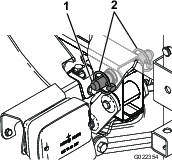
-
Install a tapered clevis pin and 2 lynch pins to the pivot lug to secure the tank assembly to the frame (Figure 11).
-
Extend the lift cylinders to raise the tank and support its weight.
Note: Disconnect the tank assembly from its overhead support.
-
Connect the existing speed sensor to the speed-sensor plug and the speed-sensor-output plug on the new wiring harness (Figure 12).

-
Use lift cylinders lower the tank to the frame.
-
Check the alignment of the tank skid and the vehicle frame.
-
Use the access panels on both sides of the tank skid to check for pinching of any hoses or wiring (Figure 13).
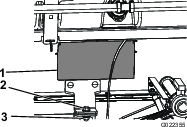
Important: If any hoses or wiring on the tank skid assembly are pinched or bent, raise the assembly up, adjust its positioning, and tie the items back.
-
Attach the pump drive.
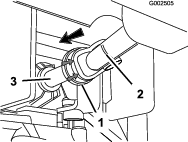
-
Pull rearward on the rubber cowling of the front of the PTO drive shaft (Figure 14).
-
Install the drive shaft onto the PTO output shaft (Figure 14).
Important: Verify that the PTO shaft is secured by making sure that the locking balls are seated in the groove of the output shaft.
-
-
Line up the front mounting brackets with the hold-down brackets installed previously.
-
Secure the tank skid assembly to the frame with a bolt (1/2 x 1-1/2 inches) and a locknut (1/2 inch) as shown in Figure 13.
Installing the Control Console and Electrical Harness
Parts needed for this procedure:
| Knob | 1 |
| J-clips | 3 |
| Bolt (1/4 x 3/4 inch) | 1 |
| Flange nut (1/4 inch) | 1 |
| Fuse decal (127–3966) | 1 |
The control box is stored on the console storage bracket on the front right tank strap.
-
Remove the hair pin securing the control console to the storage bracket.
-
Install the control console onto the control mounting bracket using the previously removed hairpin.
-
Install the hand knob to prevent the console from rotating during operation (Figure 15).
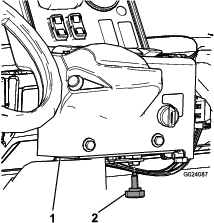
-
Install 2 J-clips in the center console at the points located in Figure 16 using the existing screws.
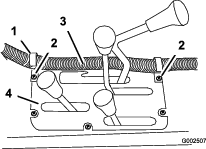
-
Install a J-clip behind the passenger seat using a bolt (1/4 x 1/2 inch) and a nut (1/4 inch) (Figure 17).

-
Secure the control console harness to the console and ROPS cover using the J-clips.
-
Slide the new fuse block into the open grooves of the existing fuse block and attach the fuse decal nearby.
-
Locate an open, yellow power wire on the existing fuse block and connect it to the yellow, optional-power wire on the new fuse block.
-
Remove the existing hardware on the battery terminals, and install the double-nut bolts (Figure 18).
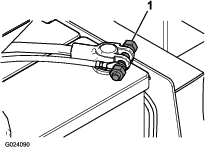
-
Connect the positive and negative battery terminals to the new wire harness.
Installing the Boom Assembly
Parts needed for this procedure:
| Center-boom assembly | 1 |
| Bolt (3/8 x 1 inch) | 10 |
| Locknut (3/8 inch) | 10 |
| Boom-transport cradle | 2 |
| Bolt (1/2 x 1-1/4 inches) | 4 |
| Flange nut (1/2 inch) | 4 |
| Left boom extension | 1 |
| Right boom extension | 1 |
-
Locate and remove the center boom assembly from packaging.
-
Mount the center boom assembly through the third hole from the bottom of the brackets on the spray system assembly, as shown in Figure 19, with 4 bolts (1/2 x 1-1/4 inches) and 4 locknuts (1/2 inch).
Note: If necessary, the boom frame mounts can be loosened and adjusted at the center boom assembly for better hole alignment.
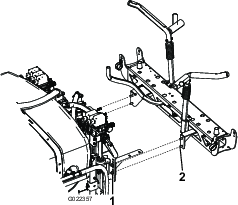
-
Install the boom transport cradles to the center boom using 6 bolts (3/8 x 1 inch) and 6 locknuts (3/8 inch).
Note: Orient them as shown in Figure 20.
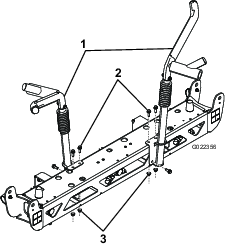
-
Remove the quick connect hose connections from the hydraulic bed lift cylinders, and connect them to the boom lift cylinder.
-
Connect the wiring harness to the hydraulic block as shown in Figure 21.
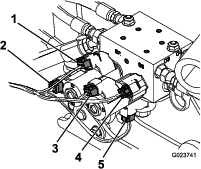
-
Remove the 4 bolts, 4 washers and 4 nuts on the hinge plate.
-
Install the extension boom to the center boom at the hinge plate using 4 bolts, 4 washers and 4 nuts removed in step 6 as shown in Figure 22.
Note: Ensure that all spray turrets are facing to the rear.
Note: Rotate the hinge plate so that it points straight up to make installation easier.
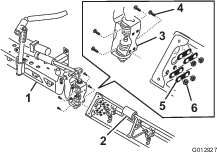
-
Repeat step 7 on the other side of the center-boom assembly with the opposing boom extension.
Note: Ensure that all spray turrets are facing the rear.
Installing the Boom Hoses
Parts needed for this procedure:
| Hose clamps | 3 |
| R-clamp | 2 |
| Shoulder bolt | 2 |
| Washer | 2 |
| Nut | 2 |
-
Route the boom hoses as shown in Figure 23.

-
Use the R-clamps to secure the right and left boom hoses to the front side of the center boom assemblies.
Note: Secure the hoses and R-clamps with a shoulder bolt, a washer and a nut as shown in Figure 23.
-
Install the boom extension hose over the barb and secure it with a clamp.
Note: Use liquid soap to coat the hose barb of the tee connections on both extension booms (Figure 24).

-
Use liquid soap to coat the hose barb of the center boom tee connection (Figure 24).
-
Route the center boom hose as shown in Figure 24.
-
Connect the center boom supply hose to the soaped barb and secure it with a hose clamp (Figure 24).
Installing the Nozzles
The nozzles that you use to apply your chemicals vary depending on the rate of application that you need; therefore, nozzles are not supplied with the kit. To obtain the correct nozzles for your needs, contact your Authorized Toro Distributor and be prepared to give them then following information:
-
The target application rate in liters per hectare, US gallons per acre, or US gallons per 1000 sq ft.
-
The target speed of the vehicle in kilometers per hour or miles per hour.
To install a nozzle, complete the following:
-
Thread or insert the nozzle into the nozzle receptacle followed by a gasket.
-
Slide the nozzle receptacle over the nozzle fitting on a turret.
-
Turn the nozzle clockwise to lock the cams on the receptacle in place.
-
Verify the fan portion of the nozzle.
See the Installation Instructions accompanying the nozzles for more information.
Installing the Fresh-water Tank
Parts needed for this procedure:
| Upper fresh-water tank mount | 1 |
| Lower fresh-water tank mount | 1 |
| Fresh-water tank | 1 |
| Flange nut (3/8 inch) | 4 |
| Washer | 2 |
| Flange-head bolt (3/8 inch) | 2 |
| Flange-head bolt (1/2 inch) | 2 |
| U-bolt | 1 |
Note: The fresh-water tank cannot be installed on a 2 post ROPS.
-
Install the upper and lower fresh-water tank mounts to the fresh-water tank using 2 flange-head bolts and flange nuts (Figure 25).
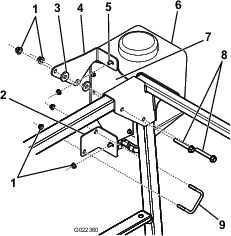
-
Attach the upper fresh-water tank mount to the ROPS using 2 washers, 2 bolts, and the existing nuts (Figure 25).
-
Secure the lower fresh-water tank mount to the ROPS using the U-bolt and 2 flange nuts (Figure 25).
Installing the Anti-siphon Fill Receptacle
Parts needed for this procedure:
| Fill receptacle assembly | 1 |
| Flange-head bolt (5/16 x 3/4 inch) | 1 |
Place the fill receptacle assembly over the threaded hole in the tank and secure it with a flange-head bolt (5/16 x 3/4 inch) (Figure 26).
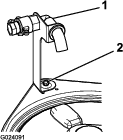
Checking the Boom Hinge Springs
Important: Operating the spray system with the boom hinge springs under the incorrect compression could damage the boom assembly. Measure the springs and use the jam nut to compress the springs to 4 cm (1–1/2 inches) if necessary.
The sprayer is shipped with the boom extensions swung forward to facilitate packaging of the machine. The springs are not fully tightened at the time of manufacture to allow the booms to be in this position for transit. Before operating the machine, adjust the springs to the correct compression.
-
If necessary, remove the packing components that secure the right and left extension booms during shipping.
-
Support the booms while they are extended to the spray position.
-
At the boom hinge, measure the compression of the upper and lower springs while the booms are in their extended position (Figure 27).
-
Compress all the springs until they measure 4 cm (1–1/2 inches).
-
Use the jam nut to compress any spring that measures greater than 4 cm (1–1/2 inches).
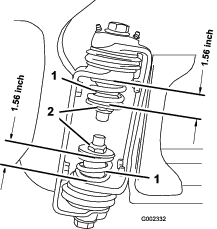
-
-
Repeat the procedure for each spring on both boom hinges.
-
Move the booms into the transport “X” position.
Note: See Using the Boom Transport Cradle for more information.
Storing the Jack Stands (Optional)
Parts needed for this procedure:
| Front jack stand | 2 |
| Rear jack stand | 2 |
| Cotter pin | 4 |
| Clevis pin (4-1/2 inch) | 2 |
| Clevis pin (3 inch) | 2 |
| Knob | 2 |
-
Insert the front jack stands upside down into the frame near the front tie-down points (Figure 28).
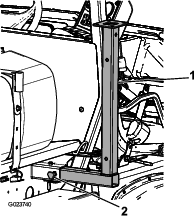
-
Secure the front jack stands with 2 clevis pins (3 inch) and 2 cotter pins through the middle hole on the stands.
-
Insert the rear jack stands from the bottom, up into the frame, near the rear tie-down points (Figure 29).
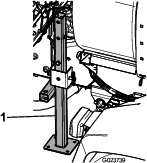
-
Secure the rear jack stands with 4 clevis pins (4-1/2 inch) and 4 cotter pins through the last hole on the stands.
Learning More about Your Product
Parts needed for this procedure:
| Operator's Manual | 1 |
| Operator training material | 1 |
| Parts Catalog | 1 |
| Registration card | 1 |
| Selection guide | 1 |
| Pre-delivery inspection sheet | 1 |
-
Read the manuals.
-
View the operator training material.
-
Use the nozzle selection guide to choose the correct nozzles for your specific application.
-
Store the documentation in a safe place.
Product Overview
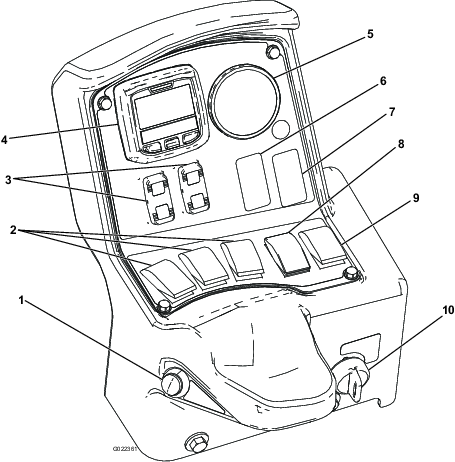
Master-boom Switch
The master-boom switch allows you to start or stop the spray operation. Press the switch to enable or disable the spray system (Figure 30).
Boom Switches
The boom switches are located along the bottom of the control panel (Figure 30). Toggle each switch upward to turn the corresponding boom section on and downward to turn them off. When the switch is turned on, a light on the switch illuminates. These switches will only affect the spray system when the master-boom switch is on.
Application-rate Switch
The application-rate switch is located on the left side of the control panel (Figure 30). Press and hold the switch upward to increase the spray system application rate, or press and hold it downward to decrease application rate.
Rate-lockout-key Switch
The rate-lockout-key switch is located on the lower, left corner of the control panel (Figure 30). Turn the key counterclockwise to the locked position to disable the application rate switch, thereby keeping anyone from accidentally changing the application rate. Turn the key clockwise to the unlocked position to enable the application rate switch.
Boom-lift Switches
The electric boom-lift switches raise and lower their respective booms (Figure 30). There is a left and right lift switch. Press and hold the switch upward to raise the respective boom, or press and hold the switch downward to lower the respective boom.
Sonic-boom and Foam-marker Switch Locations (Optional)
If you install the sonic-boom and/or the foam-marker kit, you will add switches to the control panel for controlling their operation. The sprayer comes with plastic plugs in these locations.
Regulating (Rate Control) Valve
This valve, located behind the tank (Figure 31), controls the amount of fluid that is routed to the booms by directing fluid flow to the boom.
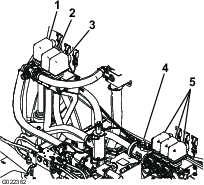
Flowmeter
The flowmeter measures the flow rate of the fluid (Figure 31).
Boom Valves
These valves turn the three booms on or off (Figure 31).
Boom-bypass Valves
The boom-bypass valves redirect the fluid flow from a boom to the tank when you turn off the boom section. You can adjust these valves to ensure that the boom pressure remains constant no matter how many booms are on. Refer to Calibrating the Boom Bypass.
Agitation-throttle Valve
This valve is located on the rear left side of the tank (Figure 32). Turn the knob on the valve to the 6 o'clock position to turn on the tank agitation and to the 8 o'clock position to turn off the tank agitation.
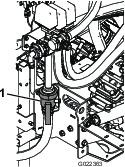
Note: For agitation to work, the PTO and clutch must be engaged, and the engine must be running above an idle. If you stop the sprayer and need agitation on, place the range shift lever in the Neutral position, let out the clutch, set the parking brake, and set the hand throttle (if equipped).
Tank-drain Handle
The tank-drain handle is located on the left side of the machine (Figure 33). To open the tank drain, turn the handle to the 3 o’clock position. To close the drain, turn the handle to the 12 o’clock position.
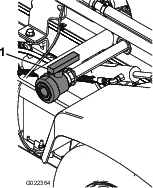
Tank Lid
The tank lid is located in the center of the top of the tank. To open it, turn off the engine and set the parking brake, then turn the front half of the cover to the left and swing it open. You can remove the strainer inside for cleaning. To seal the tank, replace the strainer if removed, close the cover, and rotate the front half toward the right.
Anti-siphon Fill Receptacle
The anti-siphon fill receptacle, in front of the tank cover, is a hose receptacle with a threaded fitting and a 90° barbed fitting which you can direct toward the tank opening. This receptacle allows you to connect a water hose and fill the tank without contaminating the hose and water supply with the chemicals in the tank. Cut the hose to a length that allows the minimum distance between the water and the end of the hose without the hose touching the water and complying with local regulations, typically 10 to 20 cm (4 to 8 inches).
Important: Do not allow the hose receptacle to contact tank fluids. Do not lengthen the hose to allow contact with the tank fluids.
InfoCenter LCD Display
The InfoCenter LCD display shows information about your machine and battery pack such as the current battery charge, the speed, diagnostics information, and more (Figure 30). For more information, refer to Using the InfoCenter LCD Display.
Note: Specifications and design are subject to change without notice.
| Spray system base weight (vehicle weight not included) | 424 kg (935 lb) |
| Tank capacity | 757 L (200 US gallons) |
| Overall vehicle length with the standard spray system | 422 cm (166 inches) |
| Overall vehicle height with standard spray system to the top of the tank | 147 cm (58 inches) |
| Overall vehicle height with standard spray system and the booms stored in the X pattern | 234 cm (92 inches) |
| Overall vehicle width with the standard spray system and the booms stored in the X pattern | 175 cm (69 inches) |
Optional Equipment
The Toro® Company has optional equipment and accessories that you can purchase separately and install on your Workman. Contact your Authorized Service Dealer for a complete list of optional equipment that is currently available for your sprayer.
Operation
Note: Determine the left and right sides of the machine from the normal operating position.
Note: If you ever need to transport the vehicle on a trailer with the sprayer attached, make sure the booms are tied down and secure.
Think Safety First
Please carefully read all of the safety instructions and decals in the safety section. Knowing this information could help you or bystanders avoid injury.
Filling the Fresh Water Tank
Always fill the fresh water tank with clean water before handling or mixing any chemicals.
The sprayer is equipped with a fresh water tank. It supplies a source of fresh water for you to wash chemicals off your skin, eyes, or other surfaces in the case of accidental exposure.
To open the fresh water tank spigot, turn the spigot lever towards the front of the sprayer.
Adjusting the Booms to Level
The following procedure can be used to adjust the actuators on the center boom to keep the left and right booms at level.
-
Extend the booms to the spray position.
-
Remove the cotter pin from the pivot pin (Figure 34).
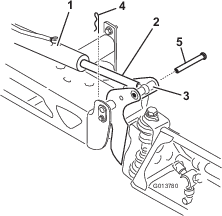
-
Lift up on the boom and remove the pin (Figure 34), and slowly lower the boom to the ground.
-
Inspect the pin for any damage, and replace it if necessary.
-
Use a wrench on the flat sides of the actuator rod to immobilize it, then loosen the jam nut to allow the eyelet rod to be manipulated (Figure 35).

-
Turn the eyelet rod in the actuator rod to shorten or lengthen the extended actuator to the desired position (Figure 35).
Note: You must turn the eyelet rod in half or complete revolutions so that you can assemble the rod to the boom.
-
Once the desired position has been achieved, tighten the jam nut to secure the actuator and eyelet rod.
-
Raise the boom to align the pivot with the actuator rod.
-
While holding the boom, insert the pin through both boom pivot and actuator rod (Figure 34).
-
With the pin in place, release the boom and secure the pin with the cotter previously removed.
-
Repeat the procedure for each actuator rod bearing, if necessary.
Operating the Sprayer
To operate the Multi Pro WM first fill the spray tank, then apply the solution to the work area, and finally clean the tank. It is important that you complete all 3 of these steps in succession to avoid damaging the sprayer. For example, do not mix and add chemicals in the spray tank at night and then spray in the morning. This would lead to separation of the chemicals and possible damage to the sprayer components.
Important: The tank markings are for reference only and cannot be considered accurate for calibration.
Caution
Chemicals are hazardous and can cause personal injury.
-
Read the directions on the chemical labels before handling the chemicals, and follow all manufacturer recommendations and precautions.
-
Keep chemicals away from your skin. Should contact occur, wash the affected area thoroughly with soap and clean water.
-
Wear goggles and any other protective equipment recommended by the chemical manufacturer.
The Multi Pro WM has been specifically designed to have high durability in order to give it the long sprayer life you need. Different materials have been chosen for specific reasons at different locations on your sprayer to meet this goal. Unfortunately there is no single material which is perfect for all foreseeable applications.
Some chemicals are more aggressive than others and each chemical interacts differently with various materials. Some consistencies (e.g. wettable powders, charcoal) are more abrasive and lead to higher than normal wear rates. If a chemical is available in a formulation that would provide increased life to the sprayer, use this alternative formulation.
Remember to clean your sprayer thoroughly after all applications. This will do the most to ensure your sprayer has a long and trouble free life.
Filling the Spray Tank
Install the Chemical Pre-Mix Kit for optimal mixing and exterior tank cleanliness.
Important: Ensure that the chemicals you will be using are compatible for use with Viton (see the manufacturer's label; it should indicate if it is not compatible). Using a chemical that is not compatible with Viton will degrade the O-rings in the sprayer, causing leaks.
Important: After filling the tank for the first time, check the tank straps for any play. Tighten them as necessary.
-
Stop the sprayer on a level surface, move the range selector to the Neutral position, stop the engine, and set the parking brake.
-
Determine the amount of water needed to mix the amount of chemical you need as prescribed by the chemical manufacturer.
-
Open the tank cover on the spray tank.
The tank lid is located in the center of the top of the tank. To open it, turn the front half of the cover counterclockwise and swing it open. You can remove the strainer inside for cleaning. To seal the tank, close the cover and rotate the front half clockwise.
-
Add 3/4 of the required water to the spray tank using the anti-siphon fill receptacle.
Important: Always use fresh clean water in the spray tank. Do not pour concentrate into an empty tank.
-
Start the engine, engage the PTO, and set the hand throttle if equipped.
-
Turn the agitation switch on.
-
Add the proper amount of chemical concentrate to the tank, as directed by the chemical manufacturer.
Important: If you are using a wettable powder, mix the powder with a small amount of water to form a slurry before adding it to the tank
-
Add the remaining water to the tank.
Note: For better agitation, decrease the application rate setting.
Operating the Booms
The boom lift switches on the sprayer control panel allow you to move the booms between the transport position and the spray position without leaving the operator's seat. Change boom positions while the machine is stationary.
Note: If the sprayer is mounted on a Workman HD/HDX/HDX-D, the vehicle must be locked into bed lift mode.
Setting the Hydraulic Lift Lock
Changing the Boom Position
-
Stop the sprayer on level ground.
-
Use the boom lift switches to lower the booms.
Note: Wait until the booms reach the full, extended spray position.
-
When the booms need to be retracted, stop the sprayer on level ground.
-
Use the boom lift switches to raise the booms, until they have moved completely into boom transport cradle forming the “X” transport position and the boom cylinders are fully retracted.
Important: To prevent damage to the boom actuator cylinder, make sure that the actuators are fully retracted before transporting the machine.
Using the Boom Transport Cradle
The sprayer is equipped with a boom transport cradle that has a unique safety feature. In the event of accidental boom contact with a low overhead object while in the transport position, the boom(s) can be pushed out of the transport cradles. If this occurs, the booms will come to rest in a near horizontal position to the rear of the vehicle. While the booms will not be damaged due to this movement, they should be immediately put back into the transport cradle.
Important: The booms can be damaged by transporting them in any position other than the “X” transport position using the boom transport cradle.
To put the booms back into the transport cradle, lower the boom(s) to the spray position, and then raise the boom(s) back into the transport position. Make sure that the boom cylinders are fully retracted to prevent actuator rod damage.
Spraying
Important: In order to ensure that your solution remains well mixed, use the agitation feature whenever you have solution in the tank. For agitation to work, the PTO must be engaged and the engine must be running above an idle. If you stop the vehicle and need agitation on, place the shift lever in the Neutral position, set the parking brake, Engage the PTO, engage the clutch, and set the hand throttle, if equipped.
Note: This procedure assumes that the PTO is engaged and the boom valve calibration has been completed.
-
Lower the booms into position.
-
Set the master boom switch to the Off position.
-
Set the individual boom switches, as needed, to the On positions.
-
Drive to the location where you will be spraying.
-
Navigate to the Application Rate screen on the InfoCenter and set the desired rate. To do this:
-
Ensure that the pump is On.
-
Select the desired gear range and begin driving to your target.
-
Verify that the monitor displays the correct application rate. If needed, manipulate the application rate switch until the monitor displays the desired application rate.
-
Return to the location where spraying is to begin.
-
-
Set the master boom switch to the On position to begin spraying.
Note: When the tank is nearly empty, the agitation may cause foaming in the tank. To prevent this, turn the agitation valve off. Alternatively, you can use an anti-foaming agent in the tank.
-
When finished spraying, set the master boom switch to the Off position to turn off all booms, then disengage the PTO lever.
Spraying Tips
-
Do not overlap areas where you have previously sprayed.
-
Watch for plugged nozzles. Replace all worn or damaged nozzles.
-
Use the master boom switch to stop the spray flow before stopping the sprayer. Once stopped, use the neutral engine speed lock to hold the engine speed up to keep the agitation running.
-
You will obtain better results if the sprayer is moving when you turn the booms on.
-
Watch for changes in the application rate that may indicate that your speed has changed beyond the range of the nozzles or there is a problem with the spray system.
Cleaning the Sprayer
Important: You must always empty and clean the sprayer immediately after each use. Failure to do so may cause the chemicals to dry or thicken in the lines, clogging the pump and other components.
Note: Install the Tank Clean Rinse Kit for optimal tank cleaning.
-
Stop the sprayer, set the parking brake, place the range selector in the Neutral position, and turn off the engine.
-
Use the tank drain valve to drain any unused material from the tank and dispose of it according to local codes and the material manufacturer's instructions.
The tank drain is located on the left side of the machine (Figure 37).

-
Fill the tank with at least 190 L (50 US gallons) of clean fresh water and close the cover.
Note: You can use a cleaning/neutralizing agent in the water as needed. On the final rinse, use only clean, clear water.
-
Start the engine.
-
With the shift lever in the Neutral position, engage the PTO, and set the hand throttle.
-
Ensure that the agitation control valve is in the On position.
-
Set both the master boom switch and boom control switches to the On position to begin spraying.
-
Allow the water in the tank to spray out though the nozzles.
-
Check the nozzles to ensure that they are all spraying correctly.
-
Set the master boom switch to the Off position, disengage the PTO, and stop the engine.
-
Repeat steps 3 through 10 at least 2 more times to ensure that the spray system is fully cleaned.
-
Clean the strainer; refer to Cleaning the Suction Strainer.
Important: If you used wetable powder chemicals, clean the strainer after each tank.
-
Using a garden hose, spray off the outside of the sprayer with clean water.
-
Remove the nozzles and clean them by hand. Replace damaged or worn nozzles.
Using the InfoCenter LCD Display
The InfoCenter LCD display shows information about your machine, such as the operating status, various diagnostics, and other information about the machine (Figure 38). There is a splash screen and main information screen on the InfoCenter. You can switch between the splash screen and main information screen, at any time, by pressing any of the InfoCenter buttons and then selecting the appropriate directional arrow.
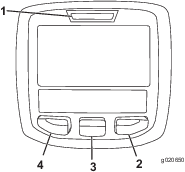
-
Left button, Menu access/Back button—press this button to access the InfoCenter menus. You can also use it to back out of any menu you are currently using.
-
Middle button—use this button to scroll down menus.
-
Right button—use this button to open a menu where a right arrow indicated additional content.
Note: The purpose of each button may change depending on what is required at the time. Each button is labeled with an icon displaying its current function.
InfoCenter Icon Descriptions
 | Information icon |
 | Hour meter |
 | Master boom On/Boom sprayer Off |
 | Master boom On/Boom sprayer On |
 | Empty spray tank |
 | Spray tank at half |
 | Full spray tank |
 or or  | TURF units (1,000 square feet) |
 | Correct PIN code entered |
 | Area sprayed |
 | Volume sprayed |
 | Exit menu |
 | Go to the home screen |
 | Save value |
 | Next |
 | Previous |
 | Scroll down |
 | Enter |
 | Increase |
 | Decrease |
 | Adjust tank volume |
 | Home screen |
 | Inactive screen |
 | Active screen |
 | Active home screen |
 | Clear active area |
 | Clear all areas |
 | Change the next value in the list |
 | Adjust digit |
 | Check PIN entry/Calibration verification |
 | Select the next area for accumulation |
 | Tank level low |
Using the Menus
To access the InfoCenter menu system, press the menu access button while at the main screen. This will bring you to the main menu. Refer to the following tables for a summary of the options available from the menus:
| Calibration | |
| Menu Item | Description |
| Test Speed | This menu sets the test speed for calibration. |
| Flow Calibration | This menu calibrates the flow meter. |
| Speed Calibration | This menu calibrates the speed sensor. |
| Settings Menu | |
| Menu Item | Description |
| Low Tank Alert | This menu sets the low tank volume alert. |
| Units | This menu changes the units used by the InfoCenter. The menu choices are English, SI, and Turf. |
| Language | This menu changes the language used on the InfoCenter. |
| LCD Backlight | This menu increases or decreases the brightness of the LCD display |
| LCD Contrast | This menu changes the contrast between the dark and light areas of the LCD display. |
| Protected Menus | This menu grants access to protected menus. |
| Service Menu | |
| Menu Item | Description |
| Faults | This menu displays the most recent faults and last cleared fault. |
| Hours | This menu lists the total number of hours for key on and machine run. It also lists the service due hour and service reset. |
| About Menu | |
| Menu Item | Description |
| Model | This menu lists the model number of the machine. |
| Serial Number | This menu lists the serial number of the machine. |
| S/W Rev. | This menu lists the revision number of the machine software. |
Note: If you inadvertently change the language or contrast to a setting where you can no longer understand or view the display, contact your Authorized Toro Distributor for assistance in resetting the display.
Calibrating the Sprayer Flow
Note: Before using the sprayer for the first time, if you change the nozzles, or as needed, calibrate the sprayer flow, speed, and boom bypass.
-
Fill the spray tank with clean water.
-
Set the parking brake and turn the engine on.
-
Set the pump switch to the On position, and turn on the agitation.
-
Press down on the accelerator pedal until you reach the maximum engine speed, and toggle the throttle lock switch to the On position.
-
Set all 3 boom switches and the master boom switch to the On position.
-
Turn the supervisor (rate lockout) switch to the Unlock position.
-
Use the application rate switch to adjust the pressure as read on the pressure gauge until it is in the range for the nozzles you installed on the booms (typically 40 psi or 2.75 bar).
-
Using a beaker, perform a catch test and adjust the application rate switch according to the table below.
Note: Repeat the test 3 times and use the average.
Nozzle Color Milliliters collected in 15 seconds Ounces collected in 15 seconds Yellow 189 6.4 Red 378 12.8 Brown 473 16.0 Gray 567 19.2 White 757 25.6 Blue 946 32.0 Green 1,419 48.0 -
Turn the supervisor (rate lockout) switch to the Lock position.
-
Turn off the master boom switch.
Note: Ensure that there is enough water in the tank to complete the calibration.
-
On the InfoCenter, navigate to the Calibration menu and select Flow Calibration.
Note: Selecting the Home Screen icon at any time will cancel calibrations.
-
Using the plus (+) and minus (-) symbols, enter the flow volume according to the table below.
Nozzle Color Liters US Gallons Yellow 42 11 Red 83 22 Brown 106 28 Gray 125 33 White 167 44 Blue 208 55 Green 314 83 -
Turn on the master boom switch for 5 minutes.
-
After 5 minutes, turn off the master boom switch and select the check mark on the InfoCenter.
Note: Calibration is now complete.
Calibrating the Sprayer Speed
Note: Before using the sprayer for the first time, if you change the nozzles, or as needed, calibrate the sprayer flow, speed, and boom bypass.
-
On an open, flat area, mark off a distance between 45–152 m (150–500 ft).
Note: For more accurate result, mark off 152 m (500 ft).
-
Start the engine and drive to the start of the marked-off distance.
Note: Align the center of the front tires with the starting line for the most accurate measurement.
-
On the InfoCenter, navigate to the Calibration menu and select Speed Calibration.
Note: Selecting the Home Screen icon at any time will cancel calibrations.
-
Fill the fresh water tank and select the Next arrow (→) on the InfoCenter.
-
Fill the spray tank halfway with fresh water and select the Next arrow (→) on the InfoCenter.
-
Using the plus (+) and minus (-) symbols, enter the marked off distance into the InfoCenter.
-
Shift the machine into first gear and drive the marked distance in a straight line at full throttle.
-
Stop the machine at the marked off distance and select the check mark on the InfoCenter.
Note: Slow down and roll to a stop to align the center of the front tires with the finish line, for the most accurate measurement.
Note: Calibration is now complete.
Calibrating the Boom Bypass
Note: Before using the sprayer for the first time, if you change the nozzles, or as needed, calibrate the sprayer flow, speed, and boom bypass.
Select an open flat area to perform this procedure.
-
Fill the spray tank halfway with clean water.
-
Lower the sprayer booms.
-
Move the range selector to the Neutral position, and set the parking brake.
-
Set the 3 boom switches to the On position, but leave the master boom switch off.
-
Set the pump switch to the On position, and turn on the agitation.
-
Press down on the accelerator pedal until you reach the maximum engine speed, and toggle the throttle lock switch to the On position.
-
On the InfoCenter, navigate to the Calibration menu and select Test Speed.
Note: Selecting the Home Screen icon at any time will cancel calibrations.
-
Using the plus (+) and minus (-) symbols, enter a test speed of 3.5, then select the Home icon.
-
Turn the supervisor (rate lockout) switch to the Unlock position, and turn the master boom switch on.
-
Using the application rate switch, adjust the application rate according to the table below.
Nozzle Application Rate Table
Nozzle Color SI (Metric) English Turf Yellow 159 L/ha 17 gpa 0.39 gpk Red 319 L/ha 34 gpa 0.78 gpk Brown 394 L/ha 42 gpa 0.96 gpk Gray 478 L/ha 51 gpa 1.17 gpk White 637 L/ha 68 gpa 1.56 gpk Blue 796 L/ha 85 gpa 1.95 gpk Green 1,190 L/ha 127 gpa 2.91 gpk -
Turn off the left boom and adjust the boom bypass valve until the pressure reading is at the previously adjusted level (typically 40 psi or 2.75 bar).
Note: The numbered indicators on the bypass valve are for reference only.
-
Turn on the left boom and turn off the right boom.
-
Adjust the right boom bypass valve until the pressure reading is at the previously adjusted level (typically 40 psi or 2.75 bar).
-
Turn on the right boom and turn off the center boom.
-
Adjust the center boom bypass valve until the pressure reading is at the previously adjusted level (typically 40 psi or 2.75 bar).
-
Turn all the booms off.
-
Turn the pump off.
Note: Calibration is now complete.
Calibrating the Agitation Bypass Valve
Select an open flat area to perform this procedure.
-
Fill the spray tank with clean water.
-
Verify the agitation control valve is open. If it has been adjusted, open it completely at this time.
-
Set the parking brake and start the engine.
-
Set the range selector to Neutral.
-
Press the accelerator to the maximum engine rpm and use the hand throttle to hold it.
Note: If the hand throttle kit is not installed, an assistant will be required.
-
Pull the PTO to engage the pump and turn the agitation switch to the On position.
-
Use the application rate switch to adjust the pressure on the gauge reads 7 bar (100 psi).
-
Turn the agitation switch to the Off position and read the pressure gauge.
-
If the reading remains at 7 bar (100 psi) the agitation bypass valve is properly calibrated.
-
If the pressure gauge reads differently continue to the next step.
-
-
Adjust the agitation bypass valve (Figure 39) on the backside of the agitation valve until the pressure reading on the gauge is 7 bar (100 psi).
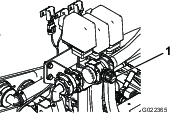
-
Turn the pump switch to the Off position. Shift the throttle lever to the Idle position and turn the ignition Off.
Locating the Pump
The pump is located near the rear of the vehicle (Figure 40).
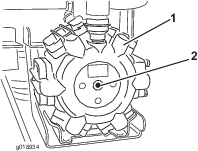
Maintenance
Note: Determine the left and right sides of the machine from the normal operating position.
Recommended Maintenance Schedule(s)
| Maintenance Service Interval | Maintenance Procedure |
|---|---|
| Before each use or daily |
|
| Every 50 hours |
|
| Every 100 hours |
|
| Every 200 hours |
|
| Every 400 hours |
|
| Yearly |
|
Important: Refer to your Workman and engine Operator's Manuals for additional maintenance procedures.
Notation for Areas of Concern
| Inspection performed by: | ||
| Item | Date | Information |
| 1 | ||
| 2 | ||
| 3 | ||
| 4 | ||
| 5 | ||
| 6 | ||
| 7 | ||
| 8 | ||
| 9 | ||
| 10 | ||
Caution
If you leave the key in the ignition switch, someone could accidently start the engine and seriously injure you or other bystanders.
Remove the key from the ignition and disconnect the wire(s) from the spark plug(s) before you do any maintenance. Set the wire(s) aside so that it does not accidentally contact the spark plug(s).
Pre-Maintenance Procedures
Accessing the Machine
Raising the Tank Assembly
Danger
The sprayer tank assembly represents a stored energy hazard. If not properly retained when installing or removing the assembly, it can move or fall and injure you or other bystanders.
Use straps and an overhead lift to support the sprayer tank assembly during installation, removal, or any maintenance when the retaining fasteners are being removed.
An empty tank assembly can be tipped or raised up to allow full access to the engine and other internal components. Pivot the boom extension forward to distribute the weight more evenly. Use the following procedure:
-
Park the vehicle with an empty tank on a level surface.
-
Use the boom control switches to raise the boom extension to approximately 45°.
-
Stop the machine, engage the parking brake, and remove the key.
-
Remove the safety bolts from the front of the skid (Figure 41).

-
Fold the boom extensions forward, alongside the tank assembly to distribute the weight more evenly, and keep it from tipping backward.
-
Raise the tank assembly until the lift cylinders are fully extended.
-
Remove the bed support from the storage brackets on back of the ROPS panel (Figure 42).
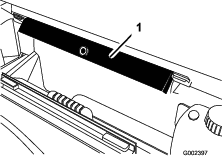
-
Push the bed support onto the cylinder rod, making sure that the support end tabs rest on the end of cylinder barrel and on the cylinder rod end (Figure 43).
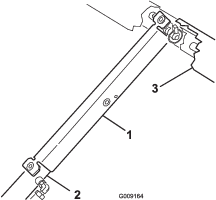
Lowering the Tank Assembly
-
When you’re ready to lower the tank assembly, remove the bed support from the cylinder and insert it into the brackets on the back of the ROPS panel.
Caution
Do not try to lower the tank assembly with the bed safety support on the cylinder.
-
Retract the lift cylinders to carefully lower the tank to the frame.
-
Install the 2 hold down bolts and fasteners to secure the tank assembly.
-
Fold the boom extensions rearward to the extended position.
-
Use the boom control switches to raise the boom extensions to the transport position.
Lubrication
Greasing the Sprayer System
| Maintenance Service Interval | Maintenance Procedure |
|---|---|
| Every 50 hours |
|
| Every 100 hours |
|
Lubricate all bearings and bushings after every 100 hours or once a year, whichever occurs first.
Grease Type: No. 2 General-purpose, lithium-base grease
-
Wipe the grease fitting clean so that foreign matter cannot be forced into the bearing or bushing.
-
Pump grease into the bearing or bushing.
-
Wipe off excess grease.

Greasing the Boom Hinges
| Maintenance Service Interval | Maintenance Procedure |
|---|---|
| Every 100 hours |
|
Important: If the boom hinge is washed with water, all water and debris must be cleared from the hinge assembly and fresh grease must be applied.
Grease Type: No. 2 general-purpose, lithium-base grease.
-
Wipe the grease fittings clean so that foreign matter cannot be forced into the bearing or bushing.
-
Pump grease into the bearing or bushing at each fitting Figure 45.
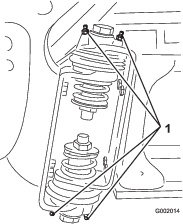
-
Wipe off excess grease.
-
Repeat this procedure for each boom pivot.
Spray System Maintenance
Warning
Chemical substances used in the spray system may be hazardous and toxic to you, bystanders, animals, plants, soils or other property.
-
Carefully read and follow the chemical warning labels and Material Safety Data Sheets (MSDS) for all chemicals used, and protect yourself according to the chemical manufacturer's recommendations. For example, use appropriate Personal Protective Equipment (PPE) including face and eye protection, gloves, or other equipment to guard against personal contact with the chemical.
-
Keep in mind that there may be more than 1 chemical used and information on each should be assessed.
-
Refuse to operate or work on the sprayer if this information is not available!
-
Before working on a spray system make sure the system has been triple rinsed and neutralized according to the recommendations of the chemical manufacturer(s) and all of the valves have been cycled 3 times.
-
Verify that there is an adequate supply of clean water and soap nearby, and immediately wash off any chemicals that contact you.
Inspecting the Hoses
| Maintenance Service Interval | Maintenance Procedure |
|---|---|
| Every 200 hours |
|
| Every 400 hours |
|
Examine each hose in the spray system for cracks, leaks, or other damage. At the same time, inspect the connections and fittings for similar damage. Replace any hoses and fittings if they are damaged.
Pump Maintenance
Inspecting the Pump
| Maintenance Service Interval | Maintenance Procedure |
|---|---|
| Every 400 hours |
|
Note: The following machine components are considered parts subject to consumption through use unless found defective and are not covered by the warranty associated with this machine.
Have an Authorized Toro Service Distributor check the following internal pump components for damage:
-
Pump diaphragms
-
Pump check valves assemblies
Replace any components if necessary.
Inspecting the Nylon Pivot Bushings
| Maintenance Service Interval | Maintenance Procedure |
|---|---|
| Every 400 hours |
|
-
Position the sprayer on a level surface, set the parking brake, stop the pump, stop the engine, and remove the ignition key.
-
Extend the booms to the spray position and support the booms using stands or straps from a lift.
-
With the weight of the boom supported, remove the bolt and nut securing the pivot pin to the boom assembly (Figure 46).
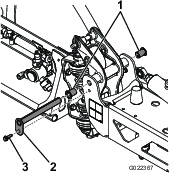
-
Remove the pivot pin.
-
Remove the boom and pivot bracket assembly from the center frame to access the nylon bushings.
-
Remove and inspect the nylon bushings from the front and back sides of the pivot bracket (Figure 46).
Note: Replace any damaged bushings.
-
Place a small amount of oil on the nylon bushings, and install them into pivot bracket.
-
Install the boom and pivot bracket assembly into the center frame, aligning the openings (Figure 46).
-
Install the pivot pin and secure it with the bolt and nut removed previously.
Repeat this procedure for each boom.
Cleaning
Cleaning the Flowmeter
| Maintenance Service Interval | Maintenance Procedure |
|---|---|
| Every 200 hours |
|
-
Thoroughly rinse and drain the entire spraying system.
-
Remove the flowmeter from the sprayer and flush it with clean water.
-
Remove the retainer ring on the upstream side (Figure 47).
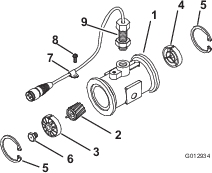
-
Clean the turbine and the turbine hub to remove metal filings and any wettable powders.
-
Inspect the turbine blades for wear.
Note: Hold the turbine in your hand and spin it. It should spin freely with very little drag. If it does not, replace it.
-
Assemble the flowmeter.
-
Use a low pressure (5 psi or 50 kPa) air jet to ensure that the turbine spins freely.
Note: If the turbine does not spin freely, loosen the hex stud on the bottom of the turbine hub by 1/16 of a turn until it does spins freely.
Cleaning the Suction Strainer
| Maintenance Service Interval | Maintenance Procedure |
|---|---|
| Before each use or daily |
|
-
Position the sprayer on a level surface, set the parking brake, stop the pump, stop the engine, and remove the ignition key.
-
Remove the retainer from the red fitting attached to the large hose on the top of the tank (Figure 48).
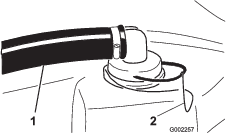
-
Disconnect the hose from the tank (Figure 48).
-
Pull the suction strainer out of the hole (Figure 49).
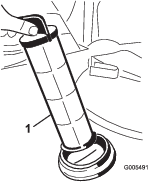
-
Clean the suction strainer with clean running water.
-
Replace the suction strainer, seating it fully into the hole.
-
Connect the hose to the top of the tank and secure it with the retainer.
Storage
-
Position the sprayer on a level surface, set the parking brake, disengage the PTO, stop the engine, and remove the ignition key.
-
Clean dirt and grime from the entire machine, including the outside of the engine's cylinder head fins and blower housing.
Important: You can wash the machine with mild detergent and water. Do not use high-pressure water to wash the machine. Pressure washing may damage the electrical system or wash away necessary grease at friction points. Avoid excessive use of water, especially near the control panel, lights, engine, and the battery.
-
Clean the spray system; refer to .
-
Clean the pistons in the valve assembly as follows:
-
Position the valves in the Off position (shaft close to the hose barb).
Note: Make sure that there is no water in the tubing.
-
Remove the 3 forks securing the valve seats to the valve assembly (Figure 50).
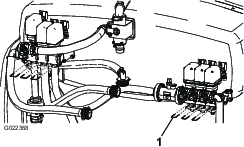
-
Using a 3 mm Allen wrench, remove the screws securing the piston assemblies in the valve assembly.
Note: Make sure to account for the springs in the valve (Figure 50).
-
Clean the pistons and replace any worn O-rings.
-
Coat all piston O-rings with vegetable oil and reinstall in the valve assembly with the screws previously removed.
Note: Make sure to install the springs into the valve assembly.
-
Secure the valve seats to the valve assembly with the 3 forks previously removed.
-
Mount the hose-boom bracket to the sprayer frame with the 2 screws and nuts previously removed.
-
-
Add a rust inhibiting, non-alcohol based, RV antifreeze solution to the system.
-
Empty the sprayer and let the pump run until the nozzles are spraying air.
-
Pour 50 L (13 US gallons) of a mix of 1/3 RV anti-freeze and 2/3 water into the sprayer tank.
-
Run the machine to distribute the anti-freeze mix throughout the system.
-
-
Use the boom lift switches to raise the booms. Raise the booms until have moved completely into boom transport cradle forming the “X” transport position and the boom cylinders are fully retracted.
Note: Make sure that the boom cylinders are fully retracted to prevent actuator rod damage.
-
Inspect the brakes; refer to the Workman Operator’s Manual.
-
Service the air cleaner; refer to the Workman Operator’s Manual.
-
Grease the sprayer; refer to the Lubrication section.
-
Check and tighten all bolts, nuts, and screws. Repair or replace any part that is damaged.
-
Check the condition of all spray hoses, replacing any that are damaged or worn.
-
Tighten all hose fittings.
-
Paint all scratched or bare metal surfaces with paint available from your Authorized Service Dealer.
-
Store the machine in a clean, dry garage or storage area.
-
Cover the machine to protect it and keep it clean.
Removing the Sprayer
If removing the sprayer from the Workman vehicle, use the following procedure and reference the Setup section.
Danger
The sprayer tank assembly represents a stored energy hazard. If not properly retained when installing or removing the assembly it can move or fall and injure you or other bystanders.
Use straps and an overhead lift to support the sprayer tank assembly during installation, removal, or any maintenance when the retaining fasteners are being removed.
-
Secure and support the sprayer tank assembly with straps to an overhead lift using the eyelets on the skid frame.
Note: This prevents the assembly from shifting when the fasteners securing the tank assembly to the frame are loosened.
-
Lower booms to approximately 45° and then pivot them forward.
-
Disconnect the wire harness and the PTO shaft.
-
Store the control box, using the existing fasteners, to the left, rear of the tank skid.
-
Remove all the fasteners retaining the sprayer tank assembly to the machine frame.
Note: Retain all parts.
-
Lift the tank assembly 7.5-10 cm (3-4 inches), and remove the lynch pins and clevis pins securing the lift cylinders to the tank assembly.
-
Retract the lift cylinders and return them to their holders on the vehicle frame.
Note: Lift the tank assembly clear of the vehicle.
-
When the sprayer tank assembly is clear of the vehicle, insert the 4 jack stands provided and lock the jack stands with the clevis pins provided.
-
Move the vehicle out of the way.
Troubleshooting
| Problem | Possible Cause | Corrective Action |
|---|---|---|
| A boom section does not spray. |
|
|
| A boom section does not turn off. |
|
|
| A boom valve is leaking. |
|
|
| A pressure drop occurs when you turn on a boom. |
|
|
Schematics
Electrical, spray system
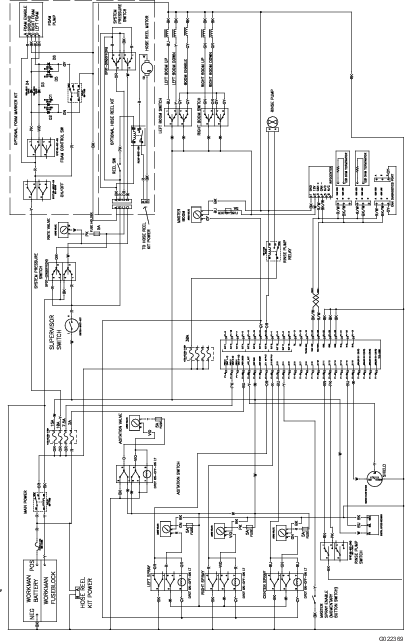
Flow Diagram
